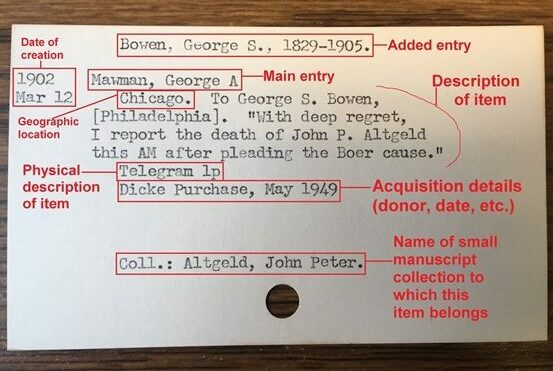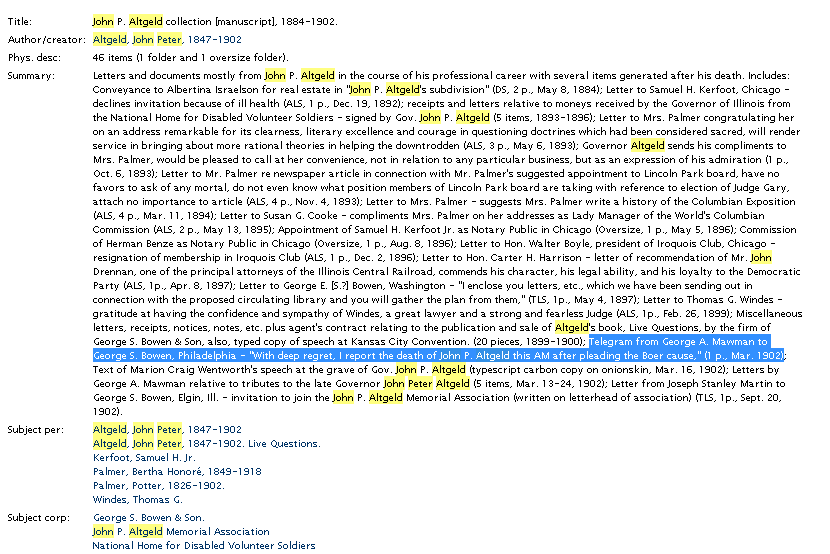CHM cataloging and metadata librarian Gretchen Neidhardt explains how the Museum is undertaking the monumental task of digitizing the last of its paper card catalog for 6,000 small manuscript collections.
The Chicago History Museum is excited to utilize an IMLS Museums for America grant to fund the digitization of our final batch of manuscript collection descriptions. While most of our manuscript collections are already in our online catalog ARCHIE, about 6,000 small manuscript collections have yet to be digitized. In recent years, physical reorganization of these collections has prepared us for this final step: converting the collection descriptions from the on-site analog card catalog to online, keyword-searchable records available to anyone anywhere in the world.

A catalog card broken down by fields. All images by CHM staff
As items were acquired, each piece within a collection of papers would be detailed on a catalog card like the one above. The card would include notes on the date, main entry (creator), place, content description, physical description, donor details, and the parent collection. Entries—or, any possible way that a researcher would want to “enter” or access the collection—were added. This card’s entry is “Bowen, George S., 1829–1905,” and it was filed alphabetically in under “Bowen.” Replicas of this card were also filed under “Mawman,” “Altgeld,” and likely “Boer War” or “South African War, 1899–1902,” to give researchers multiple pathways to locate this letter reporting the death of John P. Altgeld. Our goal is to put this rich information online so that someone searching in ARCHIE, WorldCat, ArchiveGrid, or Explore Chicago Collections can find this object and the entire collection.
In order to do that, we photocopied the entire card catalog (which is in alphabetical order) and grouped the copies by collection. We then entered each card’s data—title, description, geographic location, date, donor information, etc.—into a spreadsheet coded to match MARC (MAchine-Readable Cataloging) fields, a system that lets different programs “read” the information and return it in a usable format. The spreadsheet is put into our cataloging software, which then creates a record that is usable to researchers.

Now this one item, highlighted in the image above, is surrounded by the context of the rest of the collection, which includes forty-five other letters and items. Official Library of Congress subjects have been added, which are links to any other collections we have containing that topic. Donor information has been noted in our administrative files, and this collection is ready for online access.
Over the next eighteen months, all of our remaining catalog cards will be processed in this manner. Some highlights include:
Materials on fur traders and frontiersmen and women in seventeenth-century Chicago. Much of it is in French, such as this letter from 1693, and details business and personal relationships with the indigenous people of the area.

The embossed seal on the translation indicates that this letter was acquired in 1920 from the estate of Charles F. Gunther.
Documents about everyday Chicagoans, including a disassembled scrapbook made for the retirement of a veteran postal worker in Humboldt Park in 1924.

Rudolph Albrecht celebrated his retirement in Wicker Park.
Aggregated information about notable Chicagoans, such as Junius C. Austin, the influential African American pastor of Pilgrim Baptist Church from 1926 to 1968.

A letter to Dr. and Mrs. Austin from President Dwight D. Eisenhower.
As more collections get added to ARCHIE, the better the Museum can fulfill its mission to share Chicago’s stories.
- Want to help process our catalog cards? Apply today to be an intern!
- Visit the Museum’s Research Center